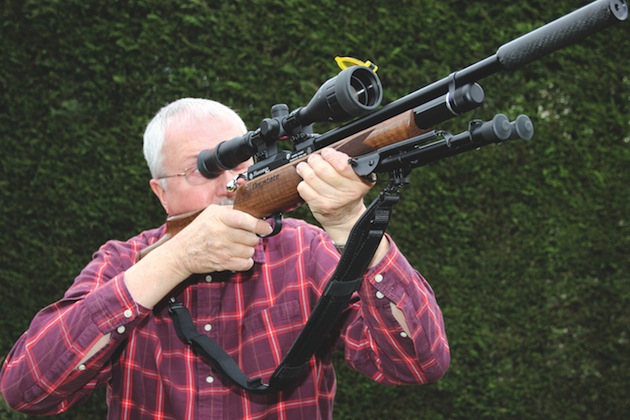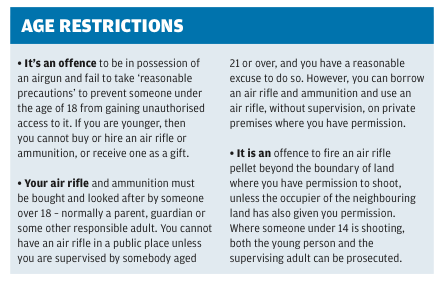Charge of the air brigade
Pre-charged air rifles are rapidly growing in popularity with pest controllers. Ian Mason visits The Airgun Centre in Essex to find out why they're flying off the shelves.

For discreet but deadly despatch of small pests you can’t beat pre-charged pneumatic (PCP) air rifles. Almost silent and astonishingly accurate, these have become the favoured tool of many rural and urban pest controllers. I keep one beside my office window. Complete with scope and moderator. It has done sterling work keeping my Surrey garden free from songbird nest raiders such as squirrels, jays and magpies.
Looking to upgrade my rifle, I happened across the website of The Airgun Centre in Rayleigh, Essex. A pal of mine recently purchased a rifle from the centre. He told me they were “very nice people.” Online feedback was also excellent, so I paid Rayleigh a visit.
The shop, owned and run by Peter Zamit, is currently celebrating its 35th anniversary, making it one of the UKs longest established air rifle retailers.
Peter has been shooting air rifles since his early teens. As a school- boy he mowed neighbours lawns to
supplement pocket-money and scrape together £18 for his first rifle, a break-barrel spring-powered BSA Super Meteor. He progressed to a Weihrauch HW 35 and then a Feinwerkbau (FWB) Sport with which he says he “shot a lot of rabbits.”
He also joined the fledging air gun business (then owned by John Stevens) straight from school, eventually taking over when John retired in 2003. Over three decades, Peter has noticed many changes in the air rifle market.
The most obvious shift has been the growing popularity of PCP air rifles (although interestingly, pneumatic rifles were first developed in the 17th century to hunt big game and were even used by Austrian army snipers in the 18th century).
PCP versus spring
“Air rifles today are massively different to those when I started,” said Peter. “Compare even a very good
spring rifle like an Air Arms TX200 with an entry level pre-charged rifle, and the PCP wins every time. It is recoilless, more consistent, more accurate, can be silenced very effectively, can be magazine fed and is generally lighter and easier to work with. It is just a better all round package.”
He currently sells around 3,500 air rifles a year; of these around a third go to people shooting live quarry. Top sellers are BSA (whose rifles go up to .25) and Daystate. The majority are 12ft/lb PCPs, however another trend has been a slow but steady increase in sales of more powerful FAC air rifles for hunting (requiring a Firearms Certificate).
“Generally speaking, these are purchased by people who shoot .22 rimfire rifles for pest control, but realise that modern PCP airguns are just as capable but a far safer option. Powerful air rifles are effective on rabbits out to 80-90 metres, but are a thousand times safer than a rimfire round,” said Peter.
The PCP is also a lot quieter and can be used for rabbit shooting on land where rimfires are excluded due to risk of ricochet towards nearby property or footpaths. “The extra killing power of a rimfire is of no use if you can’t actually pull the trigger half the time and have to leave large patches of ground unshot.”
 What pellet – what scope?
What pellet – what scope?
Air gun pellets come in many shapes and sizes such as flat-head wadcutter, domed, hollow point and pointed. For hunting rabbits, squirrels, corvids or rats, Peter says there is only one shape. “The best, most accurate and most efficient for shooting live quarry is a regular dome-head pellet. I’m not interested in anything else. Pointed pellets are less accurate and the majority of air rifles don’t have enough energy to expand hollow points on impact.”
“Top of the list is to be sure of your back stop. If you miss the target, where will your pellet end up?
Regarding pellet calibre for hunting, Peter is less definitive. “I’ve been in this business a long time. Do I know which is the best calibre to shoot live quarry? The answer is no. There is no definitive answer. It depends on personal preference, skill, distance to quarry, wind conditions – all this talk of one is better for fur and the other for feather, I don’t hold with that.”
The most popular scope he sells for air gun hunting is the Hawke Eclipse 3-2×50 IR AO Mil-Dot. “It is a nice rigid scope with good light gathering, good lens quality, it does not shift zero and has all the gadgets you might need including the popular glass etched Mil-Dot reticule with centre illumination in red or green,” explained Peter.
“Air rifle silencers have become a lot more efficient over recent years. The leaders are Hugget and then Weihrauch. Both are very efficient, but remember they only really work on PCPs, in my opinion silencers are a waste of time on spring rifles.”
His number one safety tip when air gunning bunnies or pests is obvious, but worth repeating. “Top of the list is to be sure of your back stop. If you miss, where will your pellet end up? You must know where footpaths are and always shoot away from them – an air rifle is a lethal weapon.”
Overall I was impressed with Peter and his airgun business. Even with four staff serving, there was trouble keeping up with customer demand on a busy Saturday. One reason for the shop’s popularity may be the offer of free rifle servicing for life, plus a lifetime guarantee on any purchases made – not just rifles but scopes and other accessories.
“We have to sell quality products that we know are reliable and not going to cause trouble. I’ve just swapped a scope for a customer who bought it 10 years ago. Sure this costs me money, but over the years it has also bought us a lot of repeat business.”












